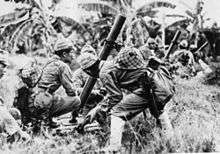Invasion of Buna–Gona
| ||||||||||||||||||||||||
The Invasion of Buna–Gona, called Operation RI by the Japanese, was a military operation by Imperial Japanese forces to occupy the Buna-Gona area in the Territory of Papua between 21 and 24 July 1942 during the Pacific campaign of the Second World War. The Japanese invaded and occupied the location to prepare for an overland attack on Port Moresby and support the advance of the Japanese forces advancing along the Kokoda Track.[1] A small Australian New Guinea Administrative Unit (ANGAU) unit and a platoon from the Papuan Infantry Battalion were in the area as the Japanese landed and were unable to contest the invasion.[2]
Background
After the Imperial Japanese had suffered setbacks at the battle of the Coral Sea and battle of Midway in May–June 1942, the Imperial General Headquarters postponed the planned operation to capture Fiji, Samoa and New Caledonia. The Japanese 17th Army's Lieutenant General Harukichi Hyakutake was tasked to conduct an offensive against Port Moresby over the Owen Stanley Range. With the occupation of Port Moresby, it would remove the threat of air attacks against Rabaul and provide airfields to conduct raids against the bases, cities and sea lane supply lines around the north of Australia.[1]
By mid-1942, however, the Allies had started to reinforce Papua and Port Moresby and had started construction of airfields at Port Moresby and Milne Bay. The Australian Army sent "B Company", 39th Battalion over the Kokoda Track towards Buna to prepare the construction of an airfield at Dobodura.[3]
Planning
With the failure to capture Port Moresby due to the battle of the Coral Sea and the subsequent return of the invasion force to Rabaul, the South Seas Detachment—led by Major General Tomitarō Horii—was attached to the 17th Army. The South Seas Detachment was to be the vanguard of the overland offensive toward Port Moresby.[1] The Yokoyama Advance Party consisted of the 1st Battalion, 144th Infantry Regiment, the 15th Independent Engineer Regiment, a company of 5th Sasebo Special Naval Landing Force, a company of 15th Naval Pioneer Unit, and other support units. The rest of the South Seas Detachment was to be transported to Buna in August 1942.[4]
The Imperial Japanese Navy 4th Fleet provided naval support including Cruiser Division 18 led by Rear Admiral Kôji Matsuyama consisting of Tenryū and Tatsuta, Destroyer Division 29 consisting of Asanagi, Yūzuki and Uzuki, and the transports Ryoyo Maru, Kinryu Maru and Ayatosan Maru. The 25th Air Flotilla and the Tainan Air Corps, based at Rabaul, were to provide air cover for the transports and the landings.[1]
Aerial reconnaissance by the 25th Air Flotilla on 27 and 30 June reported the possibility of a road between Buna and Kokoda.
Landings
On 21 July 1942, a Japanese float plane strafed the mission station at Buna at 14:40. The Japanese convoy arrived shortly afterwards off Gona and began disembarking troops. The convoy had been able to slip past the allied air force as they had been attacking a convoy off Salamaua.[5] After landing, the leading elements moved inland to prepare roads and supply lines for Port Moresby invasion force.
The platoon of the Papuan Infantry Battalion (PIB)—made up of indigenous Papuan soldiers, under an Australian officer, Lieutenant John Chalk—reported the arrival of the Japanese on the 22 July.[6] That night, Chalk and his 40-strong unit ambushed Japanese forces from a hill overlooking the Gona–Sangara road, before retreating into the jungle.
On 23 July, the area was attacked by land-based United States Army Air Forces (USSAF) B-17 and B-26 bombers, with the transport Ayatosan Maru sunk and the destroyer Uzuki damaged slightly. Daily raids are undertaken of the Buna-Gona area by the USAAF and Royal Australian Air Force planes. Further Japanese attempts to build up the force at Buna managed to get past the Allied air forces. One transport convoy got through on 25 July, but the transport Kōtoku Maru was sunk on 29 July near Salamaua, although most of the troops got ashore. A third was forced to return to Rabaul. Another convoy had to turn back on 31 July.
Aftermath

The Japanese forces had managed to capture the Buna-Gona area and were able to reinforce the advanced party. Further reinforcements in a convoy under Vice Admiral Gunichi Mikawa managed to get through on 14 August and land some 3,000 Japanese, Korean and Formosan troops of the 14th and 15th Naval Construction Units were with protection by A6M Zero fighters. On 17 August, the 5th Sasebo Special Naval Landing Force, and the rest of the 144th Regiment commanded by Lieutenant Colonel Hatsuo Tsukamoto, 55th Mountain Artillery, 47th Anti-Aircraft Artillery and 55th Cavalry arrived under the overall command of engineer Colonel Yosuke Yokoyama. On 21 August, two battalions of the 41st Regiment arrived.[7]
Colonel Yokoyama ordered Lieutenant Colonel Tsukamoto to march overland and capture the airstrip at Kokoda. These forces encountered the Australian troops deployed near Kokoda and thus the Kokoda Track campaign began.
Citations
- 1 2 3 4 "Papua prologue". Australia-Japanese Research Project. Archived from the original on September 23, 2007. Retrieved 10 January 2010.
- ↑ Brune (2004), p.100.
- ↑ Brune (2004), p.95.
- ↑ Brune (2004), p.99.
- ↑ "5th AAF movements July 1942". USAAF. Retrieved 10 January 2010.
- ↑ D. D. McNicoll, 2007, "Forgotten heroes" (The Australian, April 25, 2007) Access date: 10 January 2007.
- ↑ McCarthy, Dudley (1959), "South-West Pacific Area – First Year", Australia in the War of 1939–45
References
- Brune, Peter (2004). A Bastard of a Place: The Australians in Papua. Allen & Unwin. ISBN 1-74114-403-5.
- McCarthy, Dudley (1959). South-West Pacific Area – First Year. Australia in the War of 1939–45.